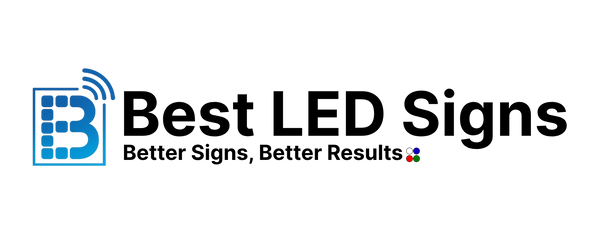Everything You Need to Know About LED Signage
LED Signs Complete Guide
Transform your business with powerful digital signage solutions that drive engagement, boost sales, and enhance customer experiences across every industry.
What Are LED Signs?
LED signs are electronic displays commonly seen across restaurants, hotels, retail stores, and transportation hubs. These versatile communication tools serve multiple purposes including brand promotion, product advertising, providing directions, and facilitating customer interactions.
They've become a popular medium of communication that reaches people during their daily activities, making them highly effective for enhancing customer experiences and driving sales growth.
Industry Applications
Transportation: Airports, train stations, and subways use LED signs to inform travelers about schedules while promoting relevant products and services.
Education: LED displays replace traditional bulletin boards and printed calendars, providing students with important information and serving as emergency alert systems.
Hospitality: Restaurants streamline ordering processes with interactive displays, while hotels provide guests with activity information and wayfinding assistance.
Benefits & Return on Investment
Although the initial investment cost for LED signage may be high, numerous benefits justify the expense. LED signs have proven to be highly cost-effective advertising methods with measurable returns. Our customers report an average 25-150% increase in revenue, with the minimum reported increase being 15%.
Business increase for car dealerships with programmable LED signs
Months to recover initial investment with increased profits
Revenue increase backed by SBA studies
Reduction in perceived waiting time
Key Benefits Include:
- Significantly increased turnover through effective promotion of sales and discounts
- Enhanced brand awareness and improved customer perception
- Additional revenue opportunities through third-party advertising
- Customer entertainment and engagement during waiting periods
- Improved internal communication and organizational efficiency
- Effective delivery of public announcements and time-sensitive information
Proven Success Statistics
Multiple studies demonstrate the effectiveness of digital signage compared to traditional advertising methods:
| Metric | Digital Signage Performance | Comparison/Details |
|---|---|---|
| Traveler Preference | 71% find billboard ads more effective | vs. Online ads |
| Brand Recall | 31% increase at point-of-sale | Leading to 30% sales increase |
| Item Promotion | 34% more effective | vs. Traditional signage |
| TV Advertisement | 46% consider LED superior | vs. Television ads |
Types of LED Signs Available
Indoor vs. Outdoor LED Signs
Indoor LED signs enhance customer experiences, provide product information, offer wayfinding assistance, and facilitate internal communication. Outdoor LED signs focus on advertising products, promotions, and creating brand awareness on busy roads and highways.
| Feature | Indoor Signs | Outdoor Signs |
|---|---|---|
| Resolution | Higher resolution for close viewing | Lower resolution for distance viewing |
| Brightness | Standard brightness | High brightness for sunlight visibility |
| Durability | Standard protection | Weather-resistant construction |
Specialized LED Sign Types
Church Signs
Specifically designed for churches to communicate messages and announcements to their congregation.
Billboard Signs
Innovative digital billboard designs that reach thousands of people driving by every day.
School Signs
Display important information and announcements to students, parents, and staff.
Restaurant Signs
Digitalized menu boards that enhance dining experiences and promote specials.
Auto Dealer Signs
Display vehicle information, promotions, and features to attract potential customers.
Mobile LED Signs
Vehicle-mounted signs that turn your fleet into messaging devices and revenue generators.
Creating Effective LED Sign Content
Creative content is the key to successful digital signage. A well-thought-out, long-term content strategy is critical for maximizing your investment.
Content Types
- Slides created using programs like MS PowerPoint
- High-quality pictures and photography
- Graphics including logos, illustrations, and icons
- Animated graphics with motion effects
- 3D graphics without special glasses required
- Video content similar to television screens
- Live feeds from broadcasting networks
- Database content like schedules and prices
Content Creation Principles
Simplicity: Keep content simple and bold so it stands out to viewers. Avoid cluttering displays with excessive text or graphics.
Brevity: Convey your message concisely within 7-10 seconds viewing time. Focus on key messages and clear calls to action.
Legibility: Use appropriate font sizes, contrasting colors, and clear fonts that are easily readable from a distance.
Audience Considerations
Tailor your content based on:
- Age: Different pacing and styles for various age groups
- Gender: Content targeting both male and female preferences
- State of Mind: Adapt to relaxed vs. focused audiences
- Dwell Time: Match content duration to viewing time
- Visit Frequency: Rotate content based on return visits
Investment Considerations
Before investing in digital signs, consider these important factors to ensure success:
Key Questions to Address
- Audience: Identify whether you're targeting employees, customers, visitors, or all groups
- Communication Goals: Determine what information you want to communicate
- Purpose: Define whether you want to lower costs, increase sales, or enhance brand image
- Content Strategy: Plan what content you'll display and who will manage it
- Hardware Requirements: Consider location, size, resolution, and mounting needs
- Campaign Flexibility: Ensure adaptability for changing objectives and consumer demands
Content Management Systems
All quality LED signs include user-friendly Content Management Systems (CMS) with drag-and-drop functionality, playlist generation, and scheduling capabilities. Look for providers offering video tutorials and lifetime tech support.
Ready to Transform Your Business?
Contact us to discuss your digital signage needs and find the perfect LED solution for your business.
- Choosing a selection results in a full page refresh.
- Opens in a new window.
